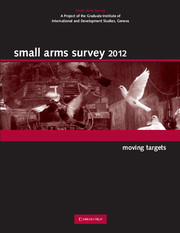Book contents
- Frontmatter
- Foreword
- Contents
- About the Small Arms Survey
- Notes to readers
- Acknowledgements
- Introduction
- Chapter 1 A Fatal Relationship: Guns and Deaths in Latin America and the Caribbean
- Chapter 2 When Business Gets Bloody: State Policy and Drug Violence
- Chapter 3 A Matter of Survival: Non-lethal Firearm Violence
- Chapter 4 Blue Skies and Dark Clouds: Kazakhstan and Small Arms
- Chapter 5 Between State and Non-state: Somaliland's Emerging Security Order
- Photo Essay. Troubled Waters: Somali Piracy
- Chapter 6 Escalation at Sea: Somali Piracy and Private Security Companies
- Chapter 7 Precedent in the Making: The UN Meeting of Governmental Experts
- Chapter 8 Piece by Piece: Authorized Transfers of Parts and Accessories
- Chapter 9 Point by Point: Trends in Transparency
- Chapter 10 Surveying the Battlefield: Illicit Arms in Afghanistan, Iraq, and Somalia
- Index
Chapter 2 - When Business Gets Bloody: State Policy and Drug Violence
Published online by Cambridge University Press: 05 February 2015
- Frontmatter
- Foreword
- Contents
- About the Small Arms Survey
- Notes to readers
- Acknowledgements
- Introduction
- Chapter 1 A Fatal Relationship: Guns and Deaths in Latin America and the Caribbean
- Chapter 2 When Business Gets Bloody: State Policy and Drug Violence
- Chapter 3 A Matter of Survival: Non-lethal Firearm Violence
- Chapter 4 Blue Skies and Dark Clouds: Kazakhstan and Small Arms
- Chapter 5 Between State and Non-state: Somaliland's Emerging Security Order
- Photo Essay. Troubled Waters: Somali Piracy
- Chapter 6 Escalation at Sea: Somali Piracy and Private Security Companies
- Chapter 7 Precedent in the Making: The UN Meeting of Governmental Experts
- Chapter 8 Piece by Piece: Authorized Transfers of Parts and Accessories
- Chapter 9 Point by Point: Trends in Transparency
- Chapter 10 Surveying the Battlefield: Illicit Arms in Afghanistan, Iraq, and Somalia
- Index
Summary
INTRODUCTION
The term ‘drug violence’ can evoke a variety of images and contexts—from interpersonal aggression by addicts and turf wars among corner dealers in retail settings to full-blown militarized confrontations among powerful, heavily armed cartels. While Latin America is home to the full spectrum of drug violence, a number of countries in the region suffer acute, destabilizing armed violence featuring large, well-armed drug trafficking operations in conflict with one another and state forces.
Mexico is the extreme case. Since President Felipe Calderón called in the army to wage an all-out war on the country's drug cartels in December 2006, more than 47,000 lives have been lost in a maelstrom of violence (Cave, 2012). While the government's crackdown has fragmented the cartels into smaller organizations, many splinter groups have proven just as violent as their predecessors. In fact, cartel violence has only grown in intensity, lethality, and brazenness since the crackdown. In addition to spiralling violence inside the country, the fragmentation of the Mexican cartels now threatens to alter the dynamics of the drug trade landscape in El Salvador, Guatemala, and Honduras.
Rio de Janeiro presents another facet of the drug violence landscape. In this city, where prison-based drug syndicates have held territorial control over the favelas (shantytowns) for more than two decades, state security forces began a new programme in 2008 to retake and then occupy favelas with long-term community-oriented police forces.
- Type
- Chapter
- Information
- Small Arms Survey 2012Moving Targets, pp. 40 - 77Publisher: Cambridge University PressPrint publication year: 2012



